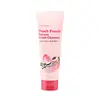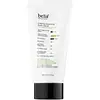What's inside
What's inside
 Key Ingredients
Key Ingredients

 Benefits
Benefits

 Concerns
Concerns

 Ingredients Side-by-side
Ingredients Side-by-side

Water
Skin ConditioningGlycerin
HumectantMyristic Acid
CleansingLauric Acid
CleansingStearic Acid
CleansingPotassium Hydroxide
BufferingCocamidopropyl Betaine
CleansingGlyceryl Stearate
EmollientSorbitan Olivate
EmulsifyingPrunus Persica Fruit Extract
AbrasivePEG-100 Stearate
Olea Europaea Fruit Oil
MaskingBetaine
HumectantSodium Chloride
MaskingPrunus Persica Fruit Water
MaskingImperata Cylindrica Root Extract
Skin ConditioningPEG-8
HumectantCarbomer
Emulsion StabilisingButylene Glycol
HumectantCaprylhydroxamic Acid
1,2-Hexanediol
Skin ConditioningCaprylyl Glycol
EmollientBoswellia Serrata Resin Extract
SmoothingParfum
MaskingDisodium EDTA
CI 16255
Cosmetic ColorantWater, Glycerin, Myristic Acid, Lauric Acid, Stearic Acid, Potassium Hydroxide, Cocamidopropyl Betaine, Glyceryl Stearate, Sorbitan Olivate, Prunus Persica Fruit Extract, PEG-100 Stearate, Olea Europaea Fruit Oil, Betaine, Sodium Chloride, Prunus Persica Fruit Water, Imperata Cylindrica Root Extract, PEG-8, Carbomer, Butylene Glycol, Caprylhydroxamic Acid, 1,2-Hexanediol, Caprylyl Glycol, Boswellia Serrata Resin Extract, Parfum, Disodium EDTA, CI 16255
Myristic Acid
CleansingWater
Skin ConditioningGlycerin
HumectantButylene Glycol
HumectantStearic Acid
CleansingPotassium Hydroxide
BufferingGlyceryl Stearate
EmollientPEG-100 Stearate
Sodium Methyl Cocoyl Taurate
CleansingPEG-40 Hydrogenated Castor Oil
EmulsifyingHydrogenated Polydecene
EmollientAvena Sativa Kernel Extract
AbrasiveCalendula Officinalis Flower Extract
MaskingNepeta Cataria Extract
TonicRubus Idaeus Leaf Extract
Skin ConditioningBaptisia Tinctoria Root Extract
Skin ConditioningStellaria Media Extract
Skin ConditioningSaponaria Officinalis Leaf Extract
AntimicrobialSapindus Mukorossi Fruit Extract
Skin ConditioningBenincasa Cerifera Seed Extract
Skin ConditioningAcorus Calamus Root Extract
PerfumingArtemisia Montana Leaf Powder
ExfoliatingTocopheryl Acetate
AntioxidantPolyquaternium-7
1,2-Hexanediol
Skin ConditioningTrisodium EDTA
Parfum
MaskingCitronellol
PerfumingLimonene
PerfumingMyristic Acid, Water, Glycerin, Butylene Glycol, Stearic Acid, Potassium Hydroxide, Glyceryl Stearate, PEG-100 Stearate, Sodium Methyl Cocoyl Taurate, PEG-40 Hydrogenated Castor Oil, Hydrogenated Polydecene, Avena Sativa Kernel Extract, Calendula Officinalis Flower Extract, Nepeta Cataria Extract, Rubus Idaeus Leaf Extract, Baptisia Tinctoria Root Extract, Stellaria Media Extract, Saponaria Officinalis Leaf Extract, Sapindus Mukorossi Fruit Extract, Benincasa Cerifera Seed Extract, Acorus Calamus Root Extract, Artemisia Montana Leaf Powder, Tocopheryl Acetate, Polyquaternium-7, 1,2-Hexanediol, Trisodium EDTA, Parfum, Citronellol, Limonene
Ingredients Explained
These ingredients are found in both products.
Ingredients higher up in an ingredient list are typically present in a larger amount.
1,2-Hexanediol is a synthetic liquid and another multi-functional powerhouse.
It is a:
- Humectant, drawing moisture into the skin
- Emollient, helping to soften skin
- Solvent, dispersing and stabilizing formulas
- Preservative booster, enhancing the antimicrobial activity of other preservatives
Butylene Glycol (or BG) is used within cosmetic products for a few different reasons:
Overall, Butylene Glycol is a safe and well-rounded ingredient that works well with other ingredients.
Though this ingredient works well with most skin types, some people with sensitive skin may experience a reaction such as allergic rashes, closed comedones, or itchiness.
Learn more about Butylene GlycolGlycerin is already naturally found in your skin. It helps moisturize and protect your skin.
A study from 2016 found glycerin to be more effective as a humectant than AHAs and hyaluronic acid.
As a humectant, it helps the skin stay hydrated by pulling moisture to your skin. The low molecular weight of glycerin allows it to pull moisture into the deeper layers of your skin.
Hydrated skin improves your skin barrier; Your skin barrier helps protect against irritants and bacteria.
Glycerin has also been found to have antimicrobial and antiviral properties. Due to these properties, glycerin is often used in wound and burn treatments.
In cosmetics, glycerin is usually derived from plants such as soybean or palm. However, it can also be sourced from animals, such as tallow or animal fat.
This ingredient is organic, colorless, odorless, and non-toxic.
Glycerin is the name for this ingredient in American English. British English uses Glycerol/Glycerine.
Learn more about GlycerinGlyceryl Stearate is a mix of glycerin and stearic acid.
It is used to stabilize the mixing of water and oil ingredients. By preventing these ingredients from separating, it can help elongate shelf life. It can also help thicken the product's texture.
As an emollient, it helps soften skin and supports barrier-replenishing ingredients.
In cosmetics, Glyceryl Stearate is often made from vegetable oils or synthetically produced.
This ingredient may not be fungal-acne safe
Fun fact: The human body also creates Glyceryl Stearate naturally.
Learn more about Glyceryl StearateMyristic Acid is a saturated fatty acid. It is naturally found in milk fat. Other sources include palm oil, coconut oil, and butter fat.
Myristic Acid is an emulsifer and cleanser. As an emulsifer, it stabilizes a product by preventing ingredients from separating. Myristic Acid helps clean your skin by acting as a surfactant. It tends to gather oil and dirt on your skin to be easily rinsed away.
One study from 2021 found Myristic Acid to have anti-inflammatory properties.
Learn more about Myristic AcidParfum is a catch-all term for an ingredient or more that is used to give a scent to products.
Also called "fragrance", this ingredient can be a blend of hundreds of chemicals or plant oils. This means every product with "fragrance" or "parfum" in the ingredients list is a different mixture.
For instance, Habanolide is a proprietary trade name for a specific aroma chemical. When used as a fragrance ingredient in cosmetics, most aroma chemicals fall under the broad labeling category of “FRAGRANCE” or “PARFUM” according to EU and US regulations.
The term 'parfum' or 'fragrance' is not regulated in many countries. In many cases, it is up to the brand to define this term.
For instance, many brands choose to label themselves as "fragrance-free" because they are not using synthetic fragrances. However, their products may still contain ingredients such as essential oils that are considered a fragrance by INCI standards.
One example is Calendula flower extract. Calendula is an essential oil that still imparts a scent or 'fragrance'.
Depending on the blend, the ingredients in the mixture can cause allergies and sensitivities on the skin. Some ingredients that are known EU allergens include linalool and citronellol.
Parfum can also be used to mask or cover an unpleasant scent.
The bottom line is: not all fragrances/parfum/ingredients are created equally. If you are worried about fragrances, we recommend taking a closer look at an ingredient. And of course, we always recommend speaking with a professional.
Learn more about ParfumPeg-100 Stearate is an emollient and emulsifier. As an emollient, it helps keep skin soft by trapping moisture in. On the other hand, emulsifiers help prevent oil and water from separating in a product.
PEGS are a hydrophilic polyether compound . There are 100 ethylene oxide monomers in Peg-100 Stearate. Peg-100 Stearate is polyethylene glycol ester of stearic acid.
Potassium hydroxide is commonly known as caustic potash. It is used to fix the pH of a product or as a cleaning agent in soap. In cleansers, it is used for the saponification of oils.
Sapnification is the process of creating fatty acid metal salts from triglycerides and a strong base. During this process, Potassium Hydroxide is used up and is not present in the final product.
Using high concentrations of Potassium Hydroxide have shown to irritate the skin.
Learn more about Potassium HydroxideStearic Acid is a fatty acid. It is an emollient, emulsifier, and texture enhancer.
As an emollient, stearic acid helps soften skin. It aids the skin's protective barrier by preventing water loss. It also provides a gentle cleansing effect without stripping away natural oils.
Stearic acid may also be used to enhance the texture of products. It can add volume and stabilize ingredients such as water and oil. This can help water and oil ingredients from separating.
Sources of stearic acid include animal or vegetable fats/oils such as coconut or shea. It can be naturally found in butter, cocoa butter, shea butter, vegetable fats, and animal tallow.
This ingredient may not be Malassezia folliculitis, or fungal-acne safe.
Learn more about Stearic AcidWater. It's the most common cosmetic ingredient of all. You'll usually see it at the top of ingredient lists, meaning that it makes up the largest part of the product.
So why is it so popular? Water most often acts as a solvent - this means that it helps dissolve other ingredients into the formulation.
You'll also recognize water as that liquid we all need to stay alive. If you see this, drink a glass of water. Stay hydrated!
Learn more about Water